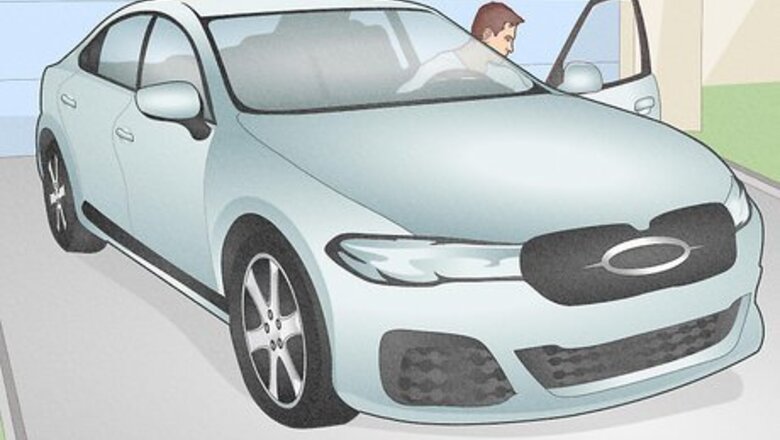
views
Park on a hard, flat surface.
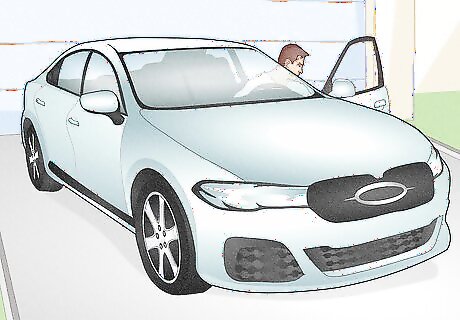
It’s important to keep your vehicle from moving while you’re underneath. Find a hard, flat surface to park on, like a concrete garage floor, a perfectly level driveway, or a parking lot. Engage the parking brake for extra measure. Avoid gravely areas, uneven fields, or areas near heavy traffic.
Elevate your car with a jack.
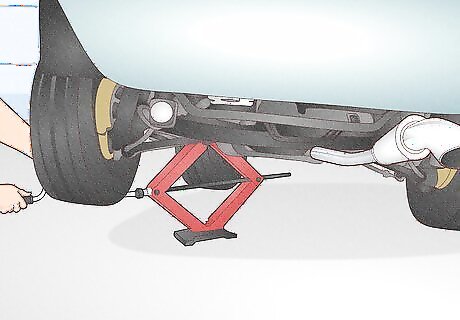
You need room to slide under the car on your back to clean thoroughly. A hydraulic or scissor jack will work—just make sure the jack and jack stands have a weight capacity of at least 50% of the car’s weight. Use the jack to lift the car and place jack stands underneath the frame to hold it up. Consult your vehicle’s owner’s manual for the best jack placement. Keep your jack stands nearby while you lift the car so you can quickly place them. If you’re de-rusting a truck, it may already be high enough off the ground without jacks. Otherwise, dealing with rust under a truck is the same as under a car.
Scrape or brush away loose rust.
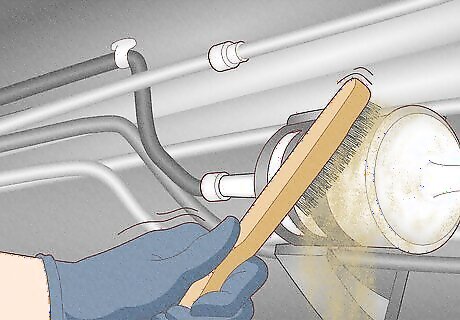
Most of the surface rust will flake off with a manual scrub. Slide or crawl underneath the car on your back and start scrubbing—use a wire brush, a metal scraper, or sandpaper (you can even add a wire brush attachment to a drill). Remove as much rust as you can so your anti-rust treatments have a metal base to cling to. Soda blasting or sandblasting the surface rust can also be good options for optimal removal. Wear goggles to prevent rust flakes from flying into your eyes. For maximum safety, keep them on for the rest of the rust treatment process, too. It’s OK if you don’t get 100% of the rust off manually. You’ll be adding liquid removal agents after this step. If there is deep rust (rust that has weakened the metal or caused holes to form), take your car to an auto shop for professional treatment or to get a replacement part. It's not possible to remove this kind of problem at home.
Wrap sensitive equipment with protective plastic.
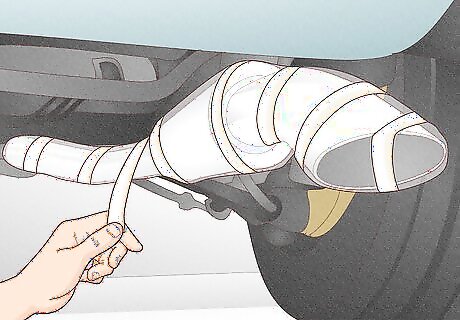
Some mechanisms shouldn’t be power washed or sprayed with chemicals. Cover the brake assembly, exhaust tips (or the whole exhaust system), the transmission, and the transfer case. Use plastic sheets, aluminum foil, or even masking tape—as long as it can block water, it’ll work! If needed, remove the wheels to easily access the wheel arches for cleaning.
Apply a degreaser to the exposed parts.
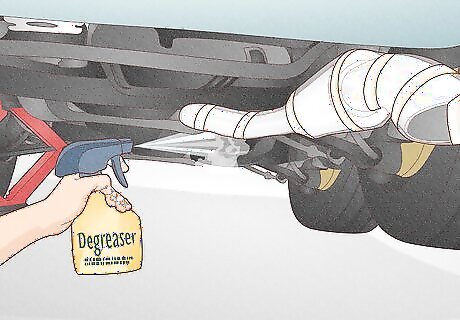
Degreaser removes heavy grime deposits that can’t be scraped off. Read the instructions carefully—for most products, you’ll spray the degreaser on and let it sit for about 20 minutes. If your degreaser is not sprayable, wipe it on with a clean towel. The degreaser removes any last oil, wax, rust flakes, or debris from the undercarriage to help primers and rust reformers stick. Purchase an auto degreaser from an auto shop, hardware store, or online.
Pressure wash the undercarriage.
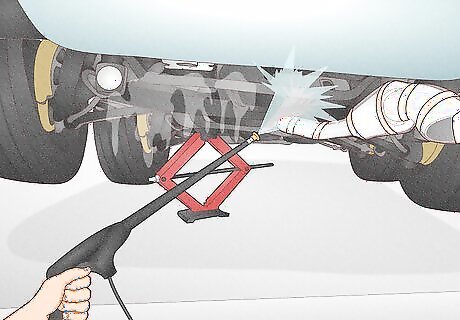
Use your pressure washer’s highest setting to blast hard-to-reach areas. Start spraying at the front of your car and work your way to the back, cleaning in sections as you go to ensure you hit everything. Spray a section until the water running off the undercarriage is clear. Wait until the undercarriage is completely dry before doing any more cleaning or applying anti-rust treatments. Place fans underneath your car to speed up the drying process.
Prime the dry undercarriage with a rust converter.
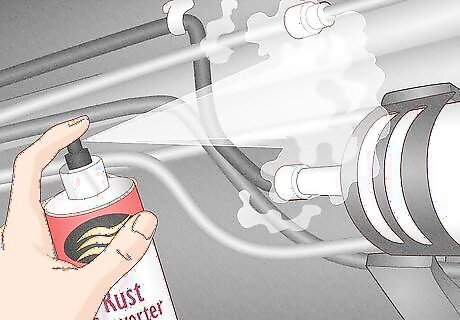
Apply right after cleaning to block dust and dirt from accumulating. Look for a high-quality rust-inhibitive primer—some are sprayable and some need to be painted on. Rust converter covers any rust spots you missed and turns them into paintable surfaces. You’ll probably need multiple coats to thoroughly coat everything. Read the primer instructions to know how long to wait between coats. Primer helps your rust reformer stick to the metal under your car. Rust converter primers are available online or at most hardware or auto shops.
Spray rust reformer on undercarriage surfaces.
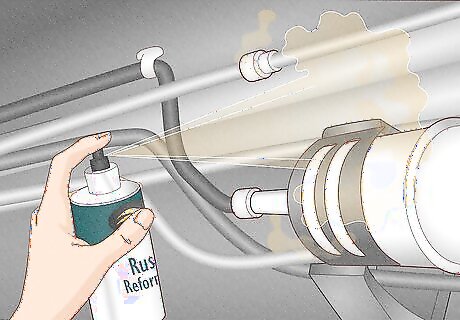
Rust reformer contains existing rust and prevents new formation. Spray your reformer on every exposed area of your undercarriage. Apply generously, especially to the brake and fuel lines (they’re the most rust-prone). You’ll probably need multiple coats, so read the instructions for how long to wait between applications (it can be up to 24 hours). Oil-based sprays work their way into small crevices easier than thicker sprays. Rust reformers are available online or at most home improvement, hardware, or auto stores.
Add a top coat of paint.
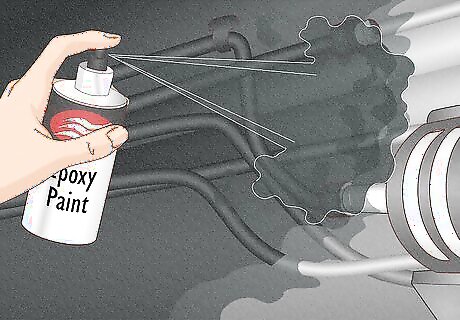
This is encouraged if you keep your car outdoors most of the time. Choose an oil-based or epoxy paint (a matte black finish is the most common). Wait until the reformer is completely dry before painting. Undercarriage paint goes quickly, so buy more than you think you need at your local auto or hardware store. This step isn't required, but it can add another layer of protection.
Pressure wash your undercarriage regularly.
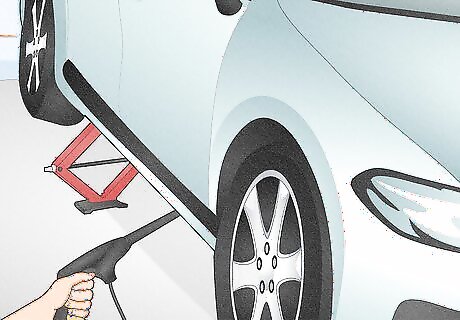
Frequent undercarriage cleaning is the best way to prevent rust. Wash it thoroughly before winter to prepare it for corrosive salt and other harsh conditions. During winter, wash your car as often as you can on warm days, including a pressure wash on the undercarriage. Wash again at the beginning of spring. Your car is most vulnerable to rust in the spring because of the moisture in the air and the fluctuating temperatures. Aim to wash your car every 10 to 20 days during winter if you can. Drive as little as possible before, during, and after winter storms when there’s extra salt on the roads.
Park in dry, clean spaces.
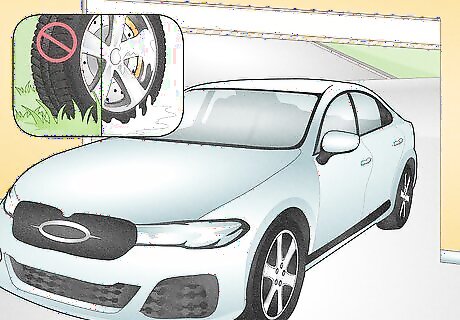
Parking on grass, snow, or puddles increases your chance of rust. Try to always park in a driveway or inside a garage if you can (your rust risk goes way down if you regularly park indoors). Cracked asphalt can also release moisture into your undercarriage, so aim to park over smooth, sealed pavement when possible. Steer clear of puddles. They contain salt and debris that wreak havoc on your undercarriage. Wash your car after excessive puddle exposure.
Check for signs of rust frequently.
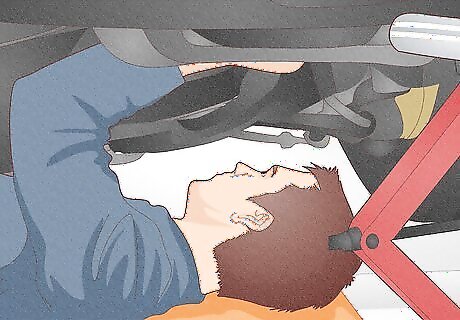
Catching rust early is the best way to prevent it spreading farther. Look for tiny nicks and scratches to buff out and paint over—they can erode and rust if left untreated. Dark spots underneath paint usually mean that the metal underneath is starting to rust. If it’s difficult to examine your undercarriage because your car sits low, lift it with jacks or ask your mechanic to take a look next time it’s in the shop.




















Comments
0 comment